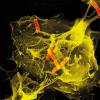Following the release of national point-of-care testing guidance, we look at the rapidly expanding sector and the vital involvement of biomedical scientists.

Though point-of-care testing (POCT) is hardly a novel concept, it really came of age during the COVID-19 pandemic. Women may have had access to home pregnancy kits since the 1970s, for example, but the countless millions of lateral flow tests and other self-administered diagnostic kits made available to the public since 2020 have redefined what is possible.
Diagnostic technology is advancing at a breathless pace, promising ever greater innovation, wider analytical range and more precise clinical application. The biggest potential benefit is that it can offer much faster results. The experience of COVID has also bolstered public demand for easier and quicker testing, and private healthcare companies have obliged. Countless products are readily available online, from test kits for food intolerance to blood cholesterol analysis. The POCT genie is not about to go back in the bottle.
It’s a new dawn in terms of our confidence and commitment to provide this advice
A new strategy
Looking to impose a sense of structure on the rapid expansion of POCT, the IBMS has worked with the Royal College of Pathologists (RCPath) and the Association of Clinical Biochemistry and Laboratory Medicine (ABC) to write and publish Point of Care Testing: National Strategic Guidance for at Point of Need Testing. The document identifies the four POCT settings of self-testing (for example, blood glucose tests, INR blood tests), home testing (pregnancy kits, COVID tests), clinical testing (GPs, community diagnostic centres, pharmacies) and hospital testing (maternity, natal, intensive therapy units, accident and emergency), along with the range of available tests, which are designed either to treat, to care, to monitor, or to protect or control.
Having set those parameters, the strategy guidance argues that laboratory medicine needs to exert its influence by providing professional expert advice and direction to anybody developing or commissioning a POCT of any sort in any of those settings.
Guiding people
David Wells, Chief Executive of the IBMS, says that the strategic guidance is aimed primarily at people outside the biomedical science laboratory profession, encouraging them to ask the right questions about POCT. “It sets out everything they need to consider if they are commissioning, designing or developing diagnostic services outside of the traditional laboratory. We’re trying to get these people on board because there are so many new services being set up within the NHS and other healthcare settings that require, or would benefit from, input.”
The hope is that they will heed the message to consult the lab professionals. “We want them to see the need for a quality management system, the need to choose the right equipment and so on, and to ask us to explain more. It’s trying to guide people before they proceed, giving them as much information as possible without overloading them.”
For Dr Michael Osborn, President of RCPath, the potential disadvantage with POCT’s rapid expansion is that people lose sight of the reason for doing it in the first place. “We are very positive about POCT. But there must be a good reason to do it. That may be because it improves patient care directly or improves the service by making it more cost effective or by engaging hard-to-reach patients. There are lots of good reasons to do it, but nobody should be doing POCT simply because they can. With a lot of interest and investment from various companies, the danger is that we have POCT that adds little to service provision. We want to make sure that it is done well and done for the benefit of patients.”
Dr Bernie Croal, President of the ABC, says that besides engaging with those outside the lab and encouraging them to think about the reasons for implementing POCT, the strategy guidance is an attempt to get them to appreciate the complexities of setting up and running a service. “Things such as laboratory input, laboratory oversight support and IT support are rarely thought about,” he says. “At the moment, some POCT services run largely within hospitals are okay, some excellent, with reasonable laboratory oversight. But a much larger base of POCT in GP practices and in the private sector has very little oversight quality, and all sorts of things could go wrong. That is the huge challenge, and any strategy that we develop and push through commissioners, the NHS or the private sector would help. The aim is to try and ensure that all POCT is developed, rolled out and performed appropriately and safely.”
FOR & AGAINST
POCT: The potential pluses
- Quicker turnaround of diagnostic results
- Speeds up treatment decisions
- Reduces the need for clinical visits and hospital admissions
- Guides and optimises drug choices
- Speeds up discharge decisions
- Relieves pressure on staff, equipment and facilities.
POCT: The potential minuses
- Often performed by staff with no technical background or formal training
- Internal and external quality assurance rarely as good as lab standards
- Wrong devices used, instructions not followed
- Devices less robust, sometimes have lower sensitivity
- Unregulated outside hospital settings
- Errors can lead to misdiagnosis and inappropriate treatment.
The first step
David Wells echoes the concerns surrounding the growth of POCT. “It can be easy to go and buy the latest test, but that might not be clinically appropriate or even helpful in terms of the patient pathway, and it may even be financially counterproductive.”
He adds, though, that the strategy guidance is not about discouraging POCT, particularly as it was produced at the request of NHS England. “The pathology team has so many calls upon its resources in terms of virtual wards, CDCs and so on, it couldn’t answer the wider strategic and policy design call. That’s why we were called in as professional bodies to draw up the strategy guidance. Everyone working in the pathology or diagnostic arena now needs to point to the document as the first step towards helping anybody setting up a POCT service. We can’t compel people to use it, but it would be a brave commissioner to wholly ignore it.”
While the document provides the all-important guidance, it’s not a step-by-step instruction manual to delivering POCT. “That’s not really what the document is about,” says Wells. Feedback comments on the work in progress typically highlighted the lack of absolute detail. “I don’t think we could ever design a document that would answer every single permutation, so we didn’t attempt to. Instead, it’s a prompt for the audience to approach the professional experts and for those experts to say, ‘let me give you my expert advice’.”
Michael Osborn agrees: “I think you can simplify this entire document down to one thing: we are the professionals who already deal with POCT, and you should involve us at every stage.”
We want to make sure that it is done well and for the benefit of patients
Bernie Croal adds that while lab professionals know the right questions to ask, understand the necessary internal and external evaluations, and can implement the proper quality controls, having the financial and workforce resources to provide an effective POCT service is a different matter. “It’s another huge challenge. Good point of care won’t happen without that funding. The guidance mentions that the funding has to cover all the important areas. If you’re putting a service together, you’ve got to look at the costs around that whole process.”
The Key Recommendations
Point of Care Testing: National Strategic Guidance for at Point of Need Testing: the key recommendations when considering and developing a point of care service
- Identify the unmet need and whether there is a test to meet it
- Involve laboratory professionals in equipment selection
- Set up an operational management system that delivers a high standard of service
- Establish a model of good clinical governance
- Define POCT and have a policy to support it within the care setting
- Ensure the described quality standards are met
- Understand the needs of the workforce, ensuring it is resourced, trained and supported
- Ensure devices are properly checked and monitored, and that the whole service is audited
- Ensure a high level of IT connectivity
- Involve laboratory teams at the earliest stage of any development
- Commit to appropriate funding and resources to deliver high-quality services
Maintaining the highest level
Among the experts asked to comment on the draft of the strategy guidance was Tony Cambridge, Lead Biomedical Scientist in Blood Sciences and POCT at University Hospitals Plymouth NHS Trust. “We’ve seen a lot of this guidance before in different formats,” he says, “but putting it into this one document as an official release from three professional bodies is really useful.”
He also agrees that proper financing and staffing are paramount. “It’s a big problem not having the resources to provide the proper oversight and good governance, to ensure that the quality of the service and the outcomes for patients are maintained at the highest levels. But I do believe this document will steer people in a better direction, especially when it comes to building a business case, putting together a team and showing what can be achieved if these services are given the right investment.”
University Hospitals Plymouth NHS Trust achieved Clinical Pathology Accreditation (CPA) for its POCT in 2012 and is now transitioning toISO15189:2022. “We feel we’re in a good position to gain accreditation probably within the next 12 months, which aligns with our quality objectives across the whole pathology,” says Cambridge.
The team is reaching out and working with other POCT services across the region and beyond. “A group that is looking at how we can work more efficiently and share best practice, and how we might adopt certain tests to improve certain pathways, whether that’s in emergency medicine, out in the community or for virtual wards.” They’re also looking to work with the commercial sector to review the utility and results of new diagnostic technology and devices.
This POCT work extends to the urgent treatment centre in Plymouth. “We’re producing a report to show the clinical utility of the results, what it has meant in terms of avoiding emergency department attendances and hospital admissions. Patients who can be managed safely outside the usual hospital system are going straight to secondary care. We are also looking at ways of working with primary care to provide additional point of care where they’ve got the clinical oversight to take decisions.”
Outcomes for patients
If Plymouth provides a good example of the hard work and thoroughness that goes into trying to do the right thing across POCT, it also demonstrates how the ultimate effectiveness of POCT must be assessed in terms of positive outcomes for patients. This notion is also at the heart of the strategy guidance. As Michael Osborn says: “We want to make sure POCT is done properly, with good governance, and for the benefit of patients.”
For Bernie Croal, the document will be a success simply if people use it. “It’s a reference point for all providers to look at and understand that if they want a particular point of care service, then they need to meet the recommendations of the strategy guidance. There’s no mandate to force that, but it’s a start. Bringing point of care under the ISO15189 umbrella is also a stepping stone.”
NHS England also has a key role to play. “They need to say, ‘this is the way things have to be’. If you want to be commissioned to do any work, services must comply with this and demonstrate that it complies. That would be a huge step forward in terms of trying to bring in regulation and standards that can be widely adopted. We, as the professionals, have stood up and said we are the experts, and this is what needs to happen.”
Calling card
David Wells also believes that the strategy guidance is a prominent professional calling card. “The world is changing dramatically. You can buy diagnostic kits in the supermarket. If we don’t change our approach to this new technology, we risk being left behind, we’ll just be seen as the people who do the lab stuff. This is a turning point, and we risk losing control of the rights to the expertise. I think this strategy guidance is timely and useful in terms of what’s happening in the world. It’s one of the few times that professional bodies have come together to give such exacting direction and in that sense it’s a new dawn in terms of our confidence and commitment to provide this advice and take better control of POCT.”




